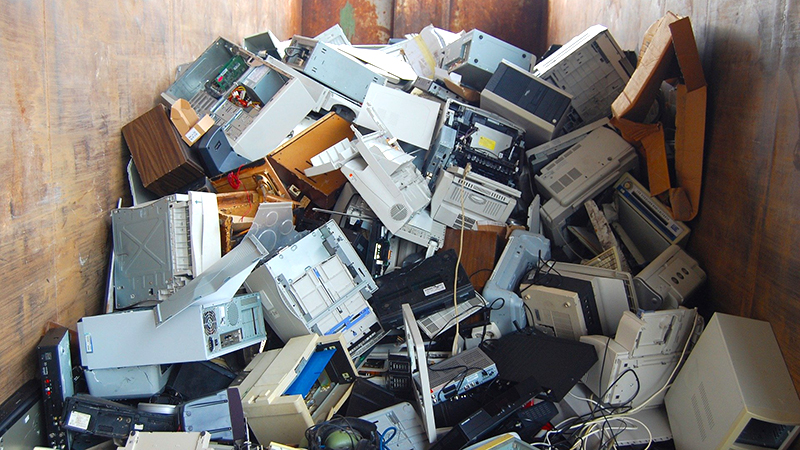Last year’s Global E-waste Monitor 2020 reported that an estimated 53.6 million metric tonnes (Mt) of WEEE was generated in 2019. That represented a 21% jump in the five years since 2014 (with e-waste on a predicted course to 74 Mt by 2030).
Global e-waste generation is therefore growing annually by 2 Mt, or about 3 to 4%, a problem attributed to higher consumption rates of electronics (increasing 3% annually), shorter product lifecycles and limited repair options.
According to estimates in Europe, where the problem is best studied, 11 of 72 electronic items in an average household are no longer in use or are broken. Annually per citizen, another 4 to 5 kg of unused electrical and electronic products are hoarded in Europe prior to being discarded.
When it comes to mobile phones, a French study estimates that 54 to 113 million mobile phones alone, weighing 10 to 20 tonnes, are sleeping in drawers and other storage spaces in French homes.
In the US, while many mobile phones are recycled, an estimated 151 million or more phones a year — approximately 416,000 a day — are trashed and end up incinerated or landfilled, and that 40% of heavy metals in US landfills come from discarded electronics.
By weight, discarded big appliances such as stoves and refrigerators constitute the largest component of e-waste. These large appliances contain steel, copper and aluminium which makes them attractive to thieves. Despite concerted efforts by governments at many levels, this problem persists. Even in the EU, which has had comprehensive Extended Producer Responsibility (EPR) legislation in place for nearly two decades, consisting of targets and legal responsibilities, the EU’s formal e-waste collection rate is 55% (2018). Huge progress has been made in the last 20 years, but member states still struggle to achieve the targets for many complex reasons, as documented by UNITAR and the Brussels-based WEEE Forum in a report.
Says Pascal Leroy, Director General of the WEEE Forum, the organisation behind International E-Waste Day: “Many factors play a role in making the electrical and electronics sector resource efficient and circular. For example, our member producer responsibility organisations collected and secured responsible recycling of 2.8 Mt of e-waste in 2020. But one thing stands out: as long as citizens don’t return their used, broken gear, sell it, or donate it, we will need to continue mining all-new materials causing great environmental damage.”
“This year’s focus for International E-Waste Day is the crucial role each of us has in making circularity a reality for e-products. This is more important than ever as our Governments go into COP26 to discuss global action to reduce carbon emissions. Every tonne of WEEE recycled avoids around 2 tonnes of CO2 emissions. If we all do the right thing with our e-waste we help to reduce harmful CO2 emissions.”
When asked about recycling rates, members of the public estimate that 40-50% of e-waste is recycled. In fact, less than half that — 17.4% — was known to be properly treated and recycled in 2019.
In the case of cell phones, tablets, computers and other small information technology products, many factors are thought to discourage recycling, including data security, product value, difficult-to-reach return points, and uncertainty about appropriate recycling, among others.
Says Ruediger Kuehr, Director of the SCYCLE Programme and Head of UNITAR’s Office in Bonn, the value of EEE components in the world’s ‘urban mines’ is enormous.
“A tonne of discarded mobile phones is richer in gold than a tonne of gold ore,” Dr. Kuehr points out.
“Embedded in 1 million cell phones, for example, are 24 kg of gold, 16,000 kg of copper, 350 kg of silver, and 14 kg of palladium — resources that could be recovered and returned to the production cycle. And if we fail to recycle these materials, new supplies need to be mined, harming the environment.”
“Moreover, the recovery of gold and other material from waste saves a lot of carbon dioxide emissions when compared with virgin metal mining,” says Kees Baldé, Senior Programme Officer of the UN University’s SCYCLE Programme.
He adds that high-value, recoverable materials conservatively valued at US $57 billion — a sum greater than the Gross Domestic Product of most countries – were mostly dumped or burned in those parts of the world without extended producer responsibility legislation in 2019 rather than being collected for treatment and reuse.
Successfully raising collection rates requires every actor to be involved, including consumers.
“Alongside convenience, financial compensation, care for the environment, culture and social norms, awareness is one of the key motivators for people to take action on e-waste,” says Magdalena Charytanowicz of the WEEE Forum in charge of International E-Waste Day.
“This is why on 14 October we hope to reach as many citizens worldwide as possible and urge the proper disposal of end-of-life electronics by encouraging campaigns and awareness activities such as e-waste collections, school lectures, and social media outreach. Even the smallest action promoting sound e-waste collection, repair, reuse or recycling is welcome in the frame of International E-Waste Day.”
“Consumers,” she adds, “want to do the right thing but need to be adequately informed and a convenient infrastructure should be easily available to them so that disposing of e-waste correctly becomes the social norm in communities.”











